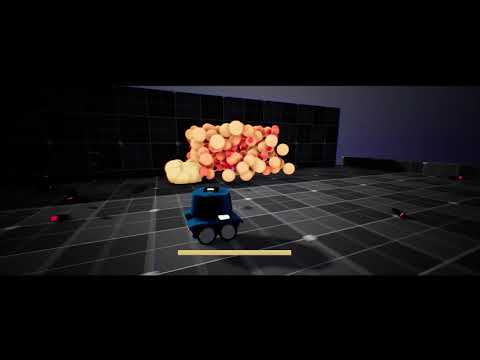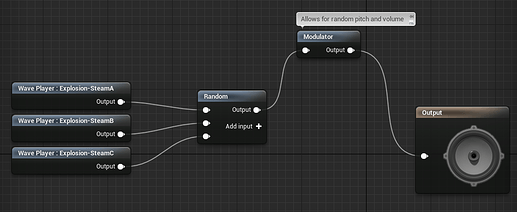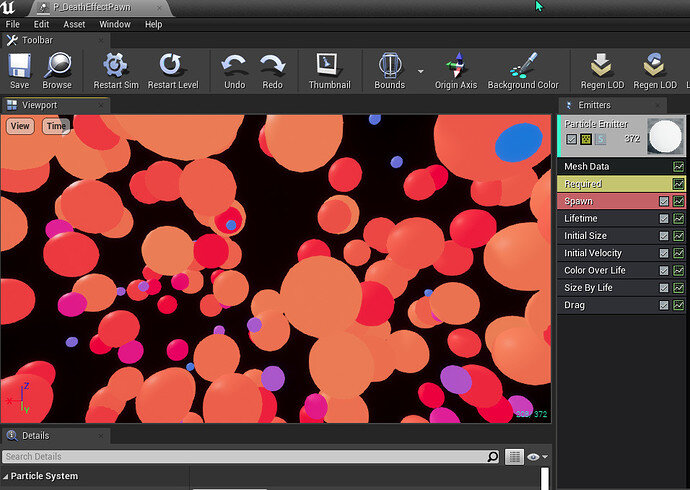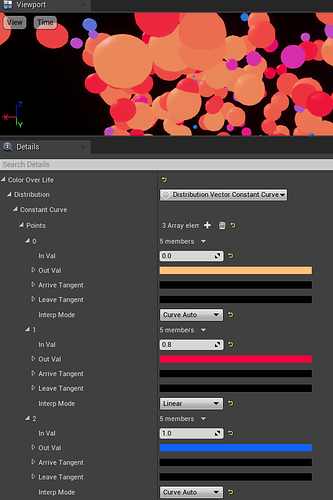I haven’t got the health progress bar widget updating correctly yet, but here’s what I’ve ended up with so far.
I made all the C++ classes available here if anyone wants to poke around, but I’ll explain the differences.
-
Sound cues were used to play random sounds. Each impact/explosion/launcher sound effect has about 3-4 variations each, as well as modulated for slightly random pitch.
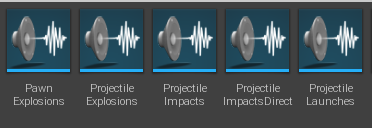
-
Attenuation is used for binaural 3d audio spatialization as well as dampening through the air with distance, which is a big reason why it sounds cool I think. This takes a lot tweaking since you don’t have visualizations for audio and frequencies like you do in something like Ableton.
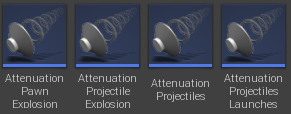
-
With so many sound sources, I had to try and arrange priority through Attenuation as well. Bigger explosions, and things closer to you generally given higher priority. Sometimes sounds randomly don’t play still and I haven’t figured it out yet.
-
Since the grenades roll and bounce on the ground, constant contact while rolling would cause a mess of sound cue spam, so I tried to use game time to set cooldowns to avoid this, as well as choose sounds that included rolling sounds for tails to help fill it out a bit.
/// Play sound effect at location, with a cooldown.
void AProjectileBase::PlaySoundNoSpam(USoundBase* SoundToPlay)
{
// This is so the hit sound doesn't spam when rolling against the ground.
WorldTime = UGameplayStatics::GetTimeSeconds(GetWorld());
float Cooldown = WorldTime - TimeHitSoundPlayed;
if (Cooldown >= 1) {
TimeHitSoundPlayed = WorldTime;
UGameplayStatics::PlaySoundAtLocation(this, SoundToPlay, GetActorLocation());
}
}
- Early on I wanted a more over-the-shoulder view, so that required input changes, camera springarm hiearchy changes, and adding a counter-rotation to allow the view and turret to decouple from tank.
// -------------------------------------------------------------------------------------------
/// Rotate turret with mouse (alternative to aiming at cursor).
void APawnTank::RotateView(float Input)
{
FRotator Rotation = TurretMesh->GetRelativeRotation();
Rotation.Yaw += Input * MouseSensitivity * GetWorld()->DeltaTimeSeconds;
TurretMesh->SetRelativeRotation(Rotation);
}
// -------------------------------------------------------------------------------------------
/// Determine rotation speed and direction on y-axis (spinning/yaw). Update RotationDirection.
void APawnTank::RotateTank(float Input)
{
float Pitch = 0;
float Yaw = Input * TurnSpeed * GetWorld()->DeltaTimeSeconds;
float Roll = 0;
FRotator Rotation = FRotator(Pitch, Yaw, Roll);
FRotator CounterRotation = FRotator(Pitch, -Yaw, Roll);
RotationDirection = FQuat(Rotation);
AddActorLocalRotation(RotationDirection, true);
// Counter rotate the turret so the view stays the same.
TurretMesh->AddLocalRotation(CounterRotation, false);
}
- I wanted to be able to hold down LMB to continuously fire, so I had to setup a little toggle function that’s called by both Pressed and Released.
// -------------------------------------------------------------------------------------------
void APawnTank::SetupPlayerInputComponent(UInputComponent* PlayerInputComponent)
{
Super::SetupPlayerInputComponent(PlayerInputComponent);
PlayerInputComponent->BindAxis("MoveForwardAndBack", this, &APawnTank::MoveTank);
PlayerInputComponent->BindAxis("TurnRightAndLeft", this, &APawnTank::RotateTank);
PlayerInputComponent->BindAxis("RotateTurret", this, &APawnTank::RotateView);
PlayerInputComponent->BindAction("Fire", IE_Pressed, this, &APawnTank::FireToggle);
PlayerInputComponent->BindAction("Fire", IE_Released, this, &APawnTank::FireToggle);
}
// -------------------------------------------------------------------------------------------
/// If IsFiring is set to true then we'll keep shooting as fast as the FireRateTimer wants us to.
void APawnTank::CheckFireCondition()
{
if (IsFiring && PlayerAlive)
Fire();
}
// -------------------------------------------------------------------------------------------
/// Toggle IsFiring bool. Only ever called on press and on release from "Fire" input.
void APawnTank::FireToggle()
{
if (!IsFiring) {
IsFiring = true;
}
else if (IsFiring) {
IsFiring = false;
}
}
- I wanted the grenades to bounce around for awhile if they missed, so I used timers to delay explosions if they didn’t hit any valid targets by the time their life span expires. This also meant I needed to be sure what the grenades were hitting were specifically a turret or the player before firing off all particles, or destruction, or sounds or anything else.
/// When this actor hits another actor. Handles damage, type, etc.
void AProjectileBase::OnHit(UPrimitiveComponent* HitComponent, AActor* OtherActor, UPrimitiveComponent* OtherComp,
FVector NormalImpulse, const FHitResult& Hit)
{
AActor* MyOwner = GetOwner();
if (!MyOwner) {
return;
}
// If we hit another actor:
if (OtherActor) {
// We can first check if the other actor is a PawnTurret or PawnTank, and save it as a bool.
IsTurret = OtherActor->GetClass()->IsChildOf(APawnTurret::StaticClass());
IsTank = OtherActor->GetClass()->IsChildOf(APawnTank::StaticClass());
}
// So if we hit a turret or the player, but not ourselves.
if (IsTurret || IsTank && OtherActor != GetOwner()) {
// Play hit particle.
UGameplayStatics::SpawnEmitterAtLocation(this, HitParticle, GetActorLocation());
// PLay metal impact sound when hit directly.
PlaySoundNoSpam(DirectImpactSound);
// Generate and apply the damage.
UGameplayStatics::ApplyDamage(
OtherActor, // Actor that will be damaged.
Damage, // Damage amount.
MyOwner->GetInstigatorController(), // Which player instigated it.
this, // What actor caused the damage.
DamageType // Type of damage done.
);
DestroyProjectile();
}
// Shake Camera if it's the player hit.
if (IsTank) {
GetWorld()->GetFirstPlayerController()->ClientStartCameraShake(HitShake, HitShakeScale);
DestroyProjectile();
}
// Play this sound whenever we bounce off anything.
PlaySoundNoSpam(ImpactSound);
// Explode the grenade after ExplosionTimer seconds if we never hit anything.
GetWorld()->GetTimerManager().SetTimer(
OUT ExplosionTimerHandle,
this,
&AProjectileBase::DestroyProjectile,
ExplosionTimer,
false
);
}
- And I added a radial impulse to the grenades when they explode, to cause all the other nearby projectiles to act as a shrapnel and bring the chaos up. I learned from another video by this section’s teacher:
C++ Physics Radial Impulse UE4 / Unreal Engine 4 C++ - YouTube
/// Check for actors in radius of explosion and apply impulse.
void AProjectileBase::CreateExplosionImpulse(FVector Location)
{
// Create basic collision shape!
FCollisionShape Spherical = FCollisionShape::MakeSphere(ImpulseRadius);
// Do a sweep check in a radius with SweepMultiChannel().
bool SweepHit = GetWorld()->SweepMultiByChannel(
OUT HitResults, // Our array of results.
GetActorLocation(), // Start location.
GetActorLocation() * 1.01f, // End location (has to be different than start).
FQuat::Identity, // Rotation (none needed, so blank FQuat).
ECC_WorldStatic, // Collision channel.
Spherical // Shape.
);
if (SweepHit) {
for (auto& Hit: HitResults) {
// First, see if the hit actor has a mesh component.
UStaticMeshComponent* Mesh = Cast<UStaticMeshComponent>(Hit.GetActor()->GetRootComponent());
// If there is, we'll apply the radial impulse to it.
if (Mesh) {
// Grab the mass so we can use more reasonable force numbers.
float Mass = Mesh->GetMass();
Mesh->AddRadialImpulse(
GetActorLocation(), // Impulse Location.
ImpulseRadius, // Radius.
ImpulseForce * Mass, // Force.
RIF_Constant, // RIF (Radial Impact Force) falloff type.
false
);
}
}
}
}


